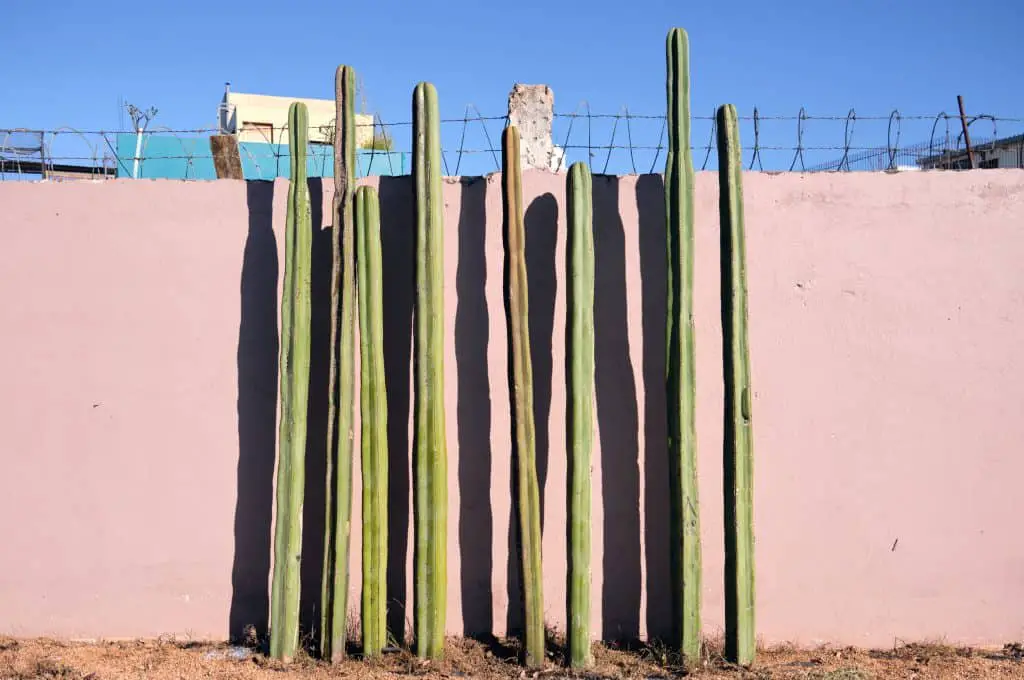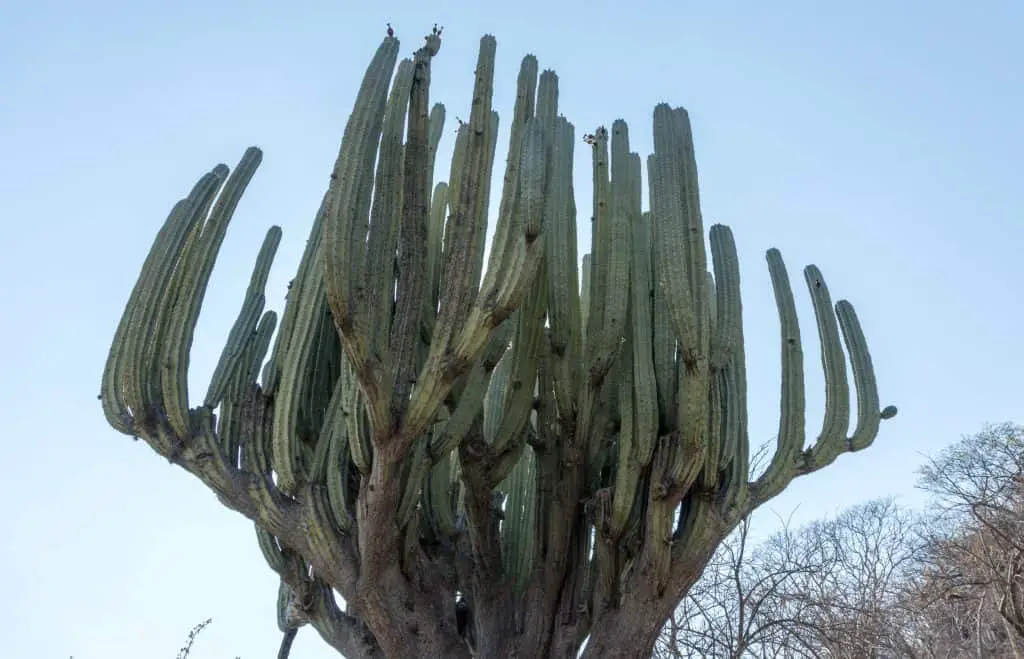| Common Name(s) | Organ pipe, organ cactus, Mexican Fence Post Cactus |
| Scientific Name | Pachycereus marginatus, Lophocereus marginatus |
| Sun Exposure | Full Sun |
| Soil pH | between 6.1 and 7.8 |
| Watering Requirement | minimal |
| Hardiness Zone | USDA 9b |
| Plant Height | 20 Feet |
| Plant Width | 6 feet |
Mexican Fence Post Cactus (Lophocereus marginatus) is a giant among cacti. Its most defining feature is its height as it can grow up to 20 feet. There are 5-7 thick ribs spaced vertically around the shaft of the cactus. There is a possibility of multiple branches growing from the main cactus stem.
Considering how tall it grows and the sharp spines all over its vertical dark green body, the Mexican Fence Post Cactus is sometimes used as a divider or barricade. (Hence the name Fence Post Cactus). This guardian plant is excellent for around a garden to protect fruits and vegetables from animals who might want to munch your crops.
Its Latin name is Lophocereus marginatus and it also has a scientific name Pachycereus marginatus. Some of Mexican Fence Post’s more common names include Organ pipe and Organ cactus because of its resemblance to the pipes on a pipe organ.
The natural growing environment is in Central Mexico where it is able to soak up the sun and take advantage of the sandy soil it needs for keeping its roots on the dry side.

Mexican Fence Post Cactus Flower
In the spring Mexican Fence Post Cactus offers up little, pinkish-red, dome-shaped flowers, they can flower into the summer as well.
Do Mexican Fence Post Cactus fruit?
Mexican Fence Post Cactus produces a dark red fruit with black seeds. The fruit is edible for humans (and birds) and is quite sweet to the taste buds.
Do Mexican Fence Post Cactus have thorns?
Mexican Fence Post Cactus are prickly. Their spines start off yellow close to the areoles and progress to white on the tips. Be sure if you are working with these cacti at all that you wear gloves to avoid being painfully pricked.
Mexican Fence Post Cactus Care
Very little effort needs to be exerted to care for Mexican Fence Post Cactus. Some sources say they are a bare minimum plant and the more you “care” for them the less happy they are. That being said they do have some requirements to stay alive.
Can you grow Mexican Fence Post Cactus indoors?
Mexican Fence Post Cactus can be grown indoors for a limited amount of time. It can grow to be 20 feet tall so it will not fit in most indoor spaces forever. If you plan to have a Mexican Fence Post Cactus indoors, have a transition plan to move it to an outdoor landscape when it outgrows your home.
Lighting Requirement
Lots of bright direct sunlight is what Mexican Fence Post Cactus loves. The optimum amount is 8-10 hours per day. They can still survive with 5-6 hours of direct sunlight, but it’s not what’s best for them.
Soil Type and pH
When considering soil for your Mexican Fence Post Cactus, conjure up images of the desert. This cactus loves a sandy soil. It should also be light, nutrient, and drain easily. If the soil remains wet there is a high chance of root rot.
Avoid compact soil as it will put damaging pressure on small roots.
The best pH levels for Mexican Fence Post Cactus are between 6.1 and 7.8.

Watering
Keep cactus watering to a minimum with Mexican Fence Post Cactus. In the summer a schedule of once every 2-3 weeks is sufficient. You can scale back to once a month watering in the winter.
Avoid watering your Mexican Fence Post Cactus at night as that can cause unwanted fluctuations in the soil temperature. Also, water your cactus with room temperature water. They are like goldilocks they don’t want their drink to be too hot or too cold. Just right.
If they are planted outside rainwater should do the job for you.
Temperature
Mexican Fence Post Cactus likes it hot! They are a desert plant and they want to live in temperatures between 70F and 80F.
Hardiness Zone
The minimum hardiness zone for Mexican Fence Post Cactus is USDA 9b.
Fertilization
Mexican Fence Post Cactus requires minimal fertilization. Two to three times annually is sufficient. The prime time for feeding your Mexican Fence Post Cactus is in the spring and summer. A light organic fertilizer will work really well.
Too much fertilization can cause harm to the roots and hinder its growth.
Stop feeding your Mexican Fence Post Cactus in the winter.
Mexican Fence Post Cactus Size
Mexican Fence Post Cactus is a very large plant. It can grow to 20 feet tall and be up to 6 feet wide.
Growth Rate
Reports have come in from a few sources of Mexican Fence Post Cactus growing up to 3 feet in a single summer season. These cacti are fast growers. Indoors they grow about 1 foot per year in a container.
Propagation
There are a few necessary tools for propagating Mexican Fence Post Cactus. Gather some heavy-duty gloves (those spines are no joke), and have a sharp knife or a razor blade and some disinfectant to clean your cutting tools.
Make sure to choose a thriving, healthy, branch with no brown spots for your propagation. Cut it off and leave it out in the open air to promote healing of the wound for about 3 days. Protect it from direct sunlight.
You can use a pre-mixed commercial cactus soil in your propagation container or mix your own using sand, pumice, and limestone. Place the cutting in the soil vertically with 1/3 of the stalk covered.
Water your Mexican Fence Post Cactus regularly until rooting takes place. Keep it out of direct sunlight until you are sure it is rooting well and on its way to being a solitary cactus.
Additionally, you can grow Mexican Fence Post Cactus from seed or buy saplings from plant stores.
Problems Growing Mexican Fence Post Cactus
If you’re on top of the care of your Mexican Fence Post Cactus most problems are avoidable.
Turning Black
Mexican Fence Post Cactus turning black is a bad sign. It means there is a fungal infection which could be crown rot, phyllosticta pad spotting, or bacterial necrosis. The best course of action is to cut away the infected area and attempt to stop the spread to other sections of the cactus as well as other plants.
Leaning sideways
The best case scenario if your Mexican Fence Post Cactus is leaning sideways is that it is reaching for more light. This is easy to remedy, just move it closer to the light source.
Another not so terrible reason for leaning is that the dirt around it is too loose. Either repot the cactus into fresh dry soil or try to pack more soil around it.
There could be an insect problem with your Mexican Fence Post Cactus. Try removing the bugs and then applying neem oil to the cactus to ward them off in the future.
Root Rot
If caught early you can remove the damaged root(s) and repot in dry soil. Avoid overwatering your Mexican Fence Post Cactus. If too much of the bottom of the cactus is affected, cut away the healthy top part. Allow it to dry and then sprinkle on some antifungal powder before replanting it in a new container of fresh dry soil.
Scales on the cactus
Cactus scales are insects. They feed on the juices of the cactus and can cause the cactus to weaken and if left untreated die.
An effective way to treat scale is to scrape it off with a flat edge. Scale doesn’t move around so they are easy to remove.
You can also use a 1-to-1 mix of rubbing alcohol and water with a few drops of dish soap to remove the scale. Just spray the areas, wait 10 minutes and wipe off the dead insects.
Common Pests
Use neem oil to protect your Mexican Fence Post Cactus from slugs, aphids, thrips, red spider mites, worms, and caterpillars.
Common Diseases
Frost damage happens when Mexican Fence Post Cactus is outside in freezing temperatures.
Cacti can turn brown when they have had too much harsh sunlight and are too dry.
Dehydration is from a lack of watering.
Root bound Mexican Fence Post Cactus occurs when repotting is neglected.
Sunburn is a possibility if your Mexican Fence Post Cactus is in intense sunlight excessively.
Where can I Find Mexican Fence Post Cactus for sale?
You can purchase Mexican Fence Post Cactus online and in some local nurseries and specialty plant stores. Pricing is dependent on size, but you can expect to pay between 25 USD and 150 USD for Mexican Fence Post Cactus.
